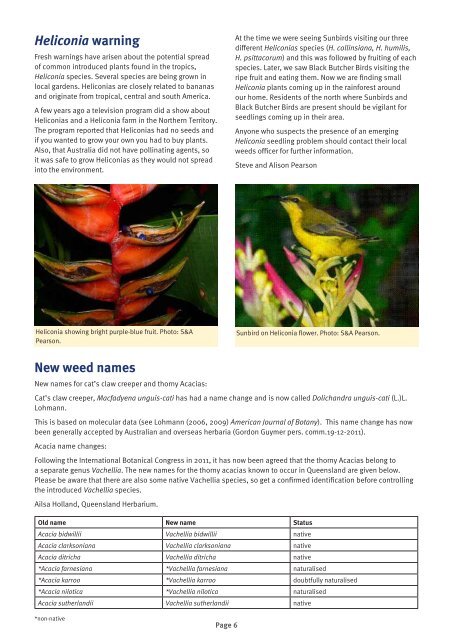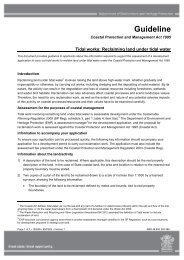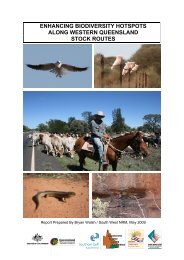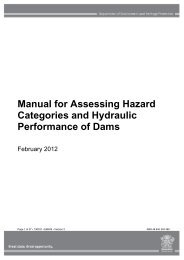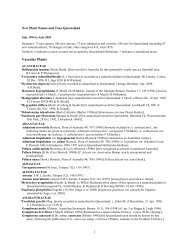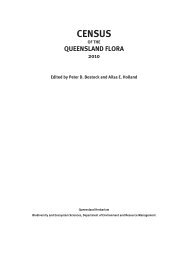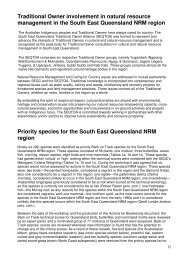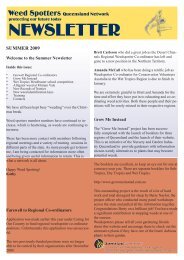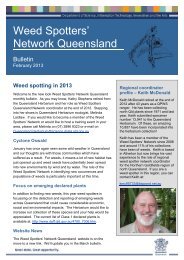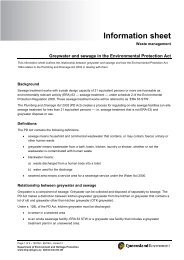Weed Spotter Queensland Network Newsletter Autumn 2012 edition
Weed Spotter Queensland Network Newsletter Autumn 2012 edition
Weed Spotter Queensland Network Newsletter Autumn 2012 edition
Create successful ePaper yourself
Turn your PDF publications into a flip-book with our unique Google optimized e-Paper software.
Heliconia warning<br />
Fresh warnings have arisen about the potential spread<br />
of common introduced plants found in the tropics,<br />
Heliconia species. Several species are being grown in<br />
local gardens. Heliconias are closely related to bananas<br />
and originate from tropical, central and south America.<br />
A few years ago a television program did a show about<br />
Heliconias and a Heliconia farm in the Northern Territory.<br />
The program reported that Heliconias had no seeds and<br />
if you wanted to grow your own you had to buy plants.<br />
Also, that Australia did not have pollinating agents, so<br />
it was safe to grow Heliconias as they would not spread<br />
into the environment.<br />
Heliconia showing bright purple-blue fruit. Photo: S&A<br />
Pearson.<br />
New weed names<br />
New names for cat’s claw creeper and thorny Acacias:<br />
Page 6<br />
At the time we were seeing Sunbirds visiting our three<br />
different Heliconias species (H. collinsiana, H. humilis,<br />
H. psittacorum) and this was followed by fruiting of each<br />
species. Later, we saw Black Butcher Birds visiting the<br />
ripe fruit and eating them. Now we are finding small<br />
Heliconia plants coming up in the rainforest around<br />
our home. Residents of the north where Sunbirds and<br />
Black Butcher Birds are present should be vigilant for<br />
seedlings coming up in their area.<br />
Anyone who suspects the presence of an emerging<br />
Heliconia seedling problem should contact their local<br />
weeds officer for further information.<br />
Steve and Alison Pearson<br />
Sunbird on Heliconia flower. Photo: S&A Pearson.<br />
Cat’s claw creeper, Macfadyena unguis-cati has had a name change and is now called Dolichandra unguis-cati (L.)L.<br />
Lohmann.<br />
This is based on molecular data (see Lohmann (2006, 2009) American Journal of Botany). This name change has now<br />
been generally accepted by Australian and overseas herbaria (Gordon Guymer pers. comm.19-12-2011).<br />
Acacia name changes:<br />
Following the International Botanical Congress in 2011, it has now been agreed that the thorny Acacias belong to<br />
a separate genus Vachellia. The new names for the thorny acacias known to occur in <strong>Queensland</strong> are given below.<br />
Please be aware that there are also some native Vachellia species, so get a confirmed identification before controlling<br />
the introduced Vachellia species.<br />
Ailsa Holland, <strong>Queensland</strong> Herbarium.<br />
Old name New name Status<br />
Acacia bidwillii Vachellia bidwillii native<br />
Acacia clarksoniana Vachellia clarksoniana native<br />
Acacia ditricha Vachellia ditricha native<br />
*Acacia farnesiana *Vachellia farnesiana naturalised<br />
*Acacia karroo *Vachellia karroo doubtfully naturalised<br />
*Acacia nilotica *Vachellia nilotica naturalised<br />
Acacia sutherlandii Vachellia sutherlandii native<br />
*non-native


